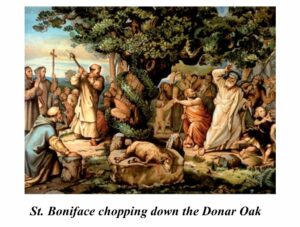This happened in Germany 1300 years ago when St Boniface was trying to convince a group of pagans to become Christians.
His problem was that they didn’t believe him, and he realised that he had to do something to convince them.
To explain at this time in Northern Europe the people believed that the oak, which they called “Donar’s Oak”, was sacred to their gods and that no harm could come to their tree.
“Donar’s Oak” was worshipped by the Germanic pagans at that time around the town we know call Hesse in Germany.
As St Boniface was travelling across Germany to convert the pagans to Christianity, he kept coming up against the tree and their belief in the tree.

He realised that there was only one thing he could do, cut down the tree. That is what he decided to do. He chose a huge Oak Tree, called the Donar Oak, and did it in public. Now, the tree was so large that everyone doubted that a single man could cut it down. However, it only took a couple of axe strokes and the mighty oak toppled over! This had the effect that the pagans saw this as a miracle showing the power of God and they accepted Jesus and converted to Christianity.
Now it appears that there are several stories as to why they converted:
- They saw that no harm had come to St Boniface, which they believed would happen.
- As the tree came down it is claimed that a small fir tree emerged from the roots of the oak tree, which St. Boniface used as a sign of the Christian faith.
- When the Oak tree fell, it split into four parts that landed on the ground in the shape of a cross.
It is the final one that could explain why the Christmas tree is now part of our celebrations.
The First Christmas Tree
It was invented by Martin Luther, the religious reformer, as he was walking through a pine forest near his home one winter’s night in 1536. As he walked, he looked up and saw a wonderous sight of thousands of stars glinting jewel-like among the branches of the trees. This gave him the idea for a candle-lit fir tree to remind his children at Christmas of the heavens from whence their Saviour came.
From then decorated Christmas trees started appearing across Southern Germany, then, again, in Germany they started being bought inside.
When did they come to England?
 When Charlotte left Germany in 1761 to marry King George, she brought the customs of setting up a yew branch in the house at Christmas. Queen Charlotte placed it in one of the largest rooms at Kew Palace or Windsor Castle. Assisted by her ladies-in-waiting, she herself dressed the bough. And when all the wax tapers had been lit, the whole Court gathered round and sang carols. The festivity ended with a distribution of gifts from the branch, which included such items as clothes, jewels, plate, toys and sweets.
When Charlotte left Germany in 1761 to marry King George, she brought the customs of setting up a yew branch in the house at Christmas. Queen Charlotte placed it in one of the largest rooms at Kew Palace or Windsor Castle. Assisted by her ladies-in-waiting, she herself dressed the bough. And when all the wax tapers had been lit, the whole Court gathered round and sang carols. The festivity ended with a distribution of gifts from the branch, which included such items as clothes, jewels, plate, toys and sweets.
Then in December, 1840, Prince Albert imported several spruce firs from his native Coburg, they were set up in Buckingham Palace.
 Our sister site, Educational Musicals tells this story in our Christmas Musical. What happened on the journey is the subject of our musical The Magic Tree – A Story for Christmas which has twelve original songs that you children will walk round the school singing.
Our sister site, Educational Musicals tells this story in our Christmas Musical. What happened on the journey is the subject of our musical The Magic Tree – A Story for Christmas which has twelve original songs that you children will walk round the school singing.
To hear two of the songs and read two pages of script click on The Magic Tree – A Story for Christmas
Enjoy the show, your children will love it.
Isn’t history fun?
10 Questions to discuss:
- What was the main obstacle St. Boniface faced in converting the pagans to Christianity?
- Why did St. Boniface decide to cut down the Donar Oak instead of using other methods of persuasion?
- According to the blog post, what are the three possible reasons why the pagans converted after the felling of the Oak?
- What evidence supports the claim that Martin Luther invented the Christmas tree tradition?
- How did Queen Charlotte contribute to introducing the Christmas tree tradition to England?
- What was the difference between Queen Charlotte’s Christmas tradition and the one Prince Albert implemented?
- Can you identify any potential biases or limitations in the information presented?
- Are there other historical accounts of the origin of the Christmas tree tradition?
- What are some alternative cultural explanations for the symbolism of the Christmas tree?
- How has the Christmas tree tradition evolved over time in different parts of the world?
To learn more click on:
© Tony Dalton

